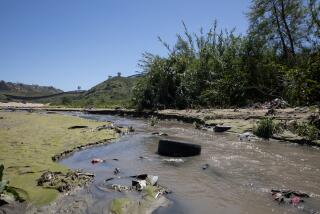Simi Valley Will Be Included in Harvard Study of Acid Pollution
In one of the first and most far-reaching studies of its kind, Harvard University has begun monitoring air quality in Simi Valley and 23 other North American communities to investigate the health effects of acid pollutants.
The $3-million project, funded by the U.S. and Canadian governments, will focus on whether airborne acids, which come from power plants and automobile exhaust, cause respiratory problems in school-age children.
Those pollutants are the same compounds found in acid rain, which is believed to harm vegetation and the facades of buildings. The Harvard study, however, will focus only on the health effect of acid particles and gasses that are directly inhaled.
“There certainly do seem to be some effects,” said Jerry Keeler, project manager for the acid study and a research scientist at the Harvard School of Public Health. “But past studies are inconclusive. There just hasn’t been enough work done to definitively answer the question.”
Completion by ’91
Of the communities selected for the project, which is expected to be completed in 1991, two-thirds were believed to have air with high acid levels and the other one-third were thought to have relatively acid-free air, Keeler said.
Although Ventura County’s ozone level is ranked by the Environmental Protection Agency as fourth worst in the nation, Keeler declined to identify Simi Valley’s category, because he feared skewing the objectivity of the study.
If participants believe their community is being studied for its clean air, he said, they tend to respond to questions in a manner that supports that premise. “If they know it’s being looked at as a dirty area,” Keeler said, “then they think, ‘Oh, we must be sick.’ ”
The monitoring of Simi Valley begins today and will continue for a year. Special equipment was shipped to the county Air Pollution Control District, which will be paid $6,270 by Harvard to take readings every other day.
This fall, questionnaires will be submitted to about 800 Simi Valley elementary-school children asking about a range of respiratory-related ailments. Young children were selected because they don’t smoke cigarettes, which could hamper the analysis, Keeler said.
Then, in the spring of 1990, Harvard researchers will conduct respiratory tests on any of the children whose parents consent to an exam.
“It may turn out that the Simi Valley area really has very moderate levels and isn’t as dirty as you would expect,” Keeler said. “It’s just important not to give people a bias beforehand.”
The only other California cities included in the study are Monterey and Livermore.
If the results indicate that acid particles pose a significant health threat, Keeler said, acids might join the five other airborne pollutants that the EPA regulates, including ozone, nitrogen dioxide and lead.
Up to now, such studies have been conducted primarily in laboratories and indicate that acids in large quantities have an acute, immediate health effect, he said. However, there is little data on the chronic, long-term effects of exposure to such pollutants.
“This is going to be very valuable to Ventura County,” said Richard H. Baldwin, the county’s air pollution control officer. “It will be good to know whether we have a problem or not.”
More to Read
Sign up for Essential California
The most important California stories and recommendations in your inbox every morning.
You may occasionally receive promotional content from the Los Angeles Times.










